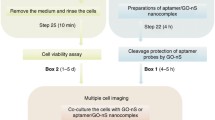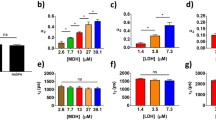Abstract
Current methods to monitor cellular ATP do not provide spatial or temporal localization of ATP in single cells in real time or they display imperfect specificity to ATP. Here, we have developed a single cell, Enhanced Acceptor Fluorescence (EAF)-based ATP biosensor to visualize ATP in real time. This biosensor utilizes a modified mimic of the ε-subunits of the Bacillus subtilis F0F1 synthase and is coupled to the EAF fluorophores pairs, GFP and YFP. The sensor was then used to monitor ATP in a heterogeneous glioblastoma multiform cancer cell population. We anticipate that this innovative technology and our better understanding of the ATP machinery will have substantial influence on future translational studies.


Similar content being viewed by others
References
Berg J, Hung YP, Yellen G (2009) A genetically encoded fluorescent reporter of ATP/ADP ratio. Nat Methods 2:161–166
Calleja V, Ameer-Beg SM, Vojnovic B, Woscholski R, Downwards J, Larijani B (2003) Monitoring conformational changes of proteins in cells by fluorescence’s lifetime imaging microscopy. Biochem J 372:33–40
Das AM (2003) Regulation of the mitochondrial ATP-synthase in health and disease. Mol Genet Metab 2:71–82
DeAngelis LM (2001) Brain tumors. N Engl J Med 344:114–123
Fang M, Chen Z, Huang S, Zhao L, Chen S, Mak TW, Wang X (2010) The ER UDPase ENTPD5 promotes protein N-glycosylation, the Warburg effect, and proliferation in the PTEN pathway. Cell 14:711–724
Glaysher S, Cree IA (2011) Cell sensitivity assays: the ATP-based tumor chemosensitivity assay. Methods Mol Bio 731:247–257
Hide I, Tanaka M, Inoue A, Nakajima K, Kohsaka S, Inoue K, Nakata Y (2000) Extracellular ATP triggers tumor necrosis factor-alpha release from rat microglia. J Neurochem 3:965–972
Imamura H, Nhat KPH, Togawa H, Saito K, Lino R, Yamada YK, Nagai T, Noji H (2009) Visualization of ATP levels inside single living cells with fluorescent resonance energy transfer-based genetically encoded indicators. Proc Natl Acad Sci USA 37:15651–15656
Israelsen WJ, Vander Heiden MG (2010) ATP consumption promotes cancer metabolism. Cell 143:669–671
Locasale JW, Cantley LC (2012) Altered metabolism in cancer. BMC Biol 8:88
Parsons DW, Jones S, Zhang X, Lin JC, Leary RJ, Angenendt P (2008) An integrated genomic analysis of human glioblastoma multiform. Science 5897:1807–1812
Pérez-Flores I, Sánchez-Fructuoso A, Santiago JL, Fernández-Arquero M, Calvo N, Gómez de la Concha E, Barrientos A (2009) Intracellular ATP levels in CD4+ lymphocytes are a risk marker of rejection and infection in renal graft recipients. Transpl Proc 6:2106–2108
Stephenson K, Hoch JA (2001) PAS-A domain of phosphorelay sensor kinase A: a catalytic ATP-binding domain involved in the initiaton of development in Bacillus subtilis. Proc Natl Acad Sci USA 98:15251–15256
Tsujimoto Y (1997) Apoptosis and necrosis: intracellular ATP as a determinant for cell death modes. Cell Death Differ 6:429–434
Vander Heiden MG, Cantley L, Thompson C (2009) Understanding the Warburg effect: the metabolic requirements of cell proliferation. Science 5930:1029–1033
Zadran S, Qin Q, Bi X, Zadran H, Kim Y, Foy MR, Thompson R, Baudry M (2009) 17-B Estradiol increases neuronal excitability through MAP kinase-induced calpain activation. Proc Natl Acad Sci USA 51:21936–21941
Acknowledgments
We would also like to thank Dr. Raphael Levine (UCLA) and Dr. Michel Baudry (USC) for critical analysis and discussions. We would like to thank the UCLA Brain Tumor Translational Resource for biospecimen support. The UCLA David Geffen School of Medicine for early career funds to S. Zadran and the National Science Foundation Graduate Research Fellowship Program (GRFP) to H. Zadran supported this work.
Author information
Authors and Affiliations
Corresponding author
Rights and permissions
About this article
Cite this article
Zadran, S., Sanchez, D., Zadran, H. et al. Enhanced-acceptor fluorescence-based single cell ATP biosensor monitors ATP in heterogeneous cancer populations in real time. Biotechnol Lett 35, 175–180 (2013). https://doi.org/10.1007/s10529-012-1065-6
Received:
Accepted:
Published:
Issue Date:
DOI: https://doi.org/10.1007/s10529-012-1065-6




